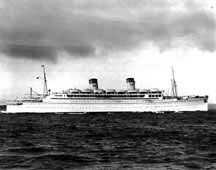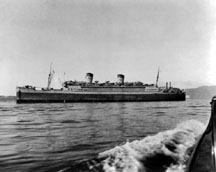TSgt. Allan #1
Letter #1 "Leaving San Francisco"
Note: Pictures added for clarity. Pictures are not necessarily originals from TSgt. Allan.
January 1942
"The whole front end is packed with bombs? But this is a troop ship!"
This rumor (and reaction) was thrown around and was of some concern as
we zig zagged through what we supposed was a war zone. It eased a lot
when the rumor was added that the whole middle was packed with Scotch.
There was an old saying in the Army that rumors were all too often true.
Fools that we were, we thought we would be getting some Scotch with our
rations. When this was totally scoffed at, we relaxed about the bombs
too. Our ship, the Mariposa, with two others, sailed from San Francisco.
 |
The Mariposa Leaving San Francisco Editor's Note: The Mariposa later distinguished herself by bringing home part of the AVG (original Flying Tigers) after the Air Force took them over in 1942.* *"FEI
HU" The Flying Tigers, |
We watched as we left the Golden Gate bridge far behind. It was an odd feeling seeing the tall towers sink slowly into the blue Pacific. For a while after they were no longer to be seen, you could hear a pin drop any where on that ship. Seeing The Golden Gate disappear made it real somehow -- we really were off to war. After the first day out in the first week in January 1942, it was mostly all fun -- examining all the features of this once paradise ship.
|
|
The Mariposa, a once paradise ship |
In her prewar days, the Mariposa was a grand, and beautiful, ship. She was the luxury queen of the passenger ships plying the South Pacific. Unlike her past cruises, there were only male soldiers on the decks this time. A sad fact that we lamented right away. I overheard a ship's officer remark that when the Yanks got through with her, there would be little left of their "lovely" old queen! Sadly, it didn't take long for the American GIs to prove him correct and get a bad start in the world of good intentions (this was only the first time).
 |
|
The Philippines was our destination -- to help take back Corregidor! "Take back Corregidor? We were Sad Sacks! Technicians, not trained to be fighting men." We took that news with some trepidation, but still, we were anxious to get somewhere. When the Philippines fell to the Japs before we could get there, our final, substitute destination became the East Indies. It took three more weeks to get to Australia. So, we put in on the Southern side of this great, unknown, and unheard of (by us in 1942) island continent.
These times were to become the greatest time in my life -- learning all there was to learn, in such a short time! We all enjoyed a clarity of purpose and unity unequaled since We stayed at a vacant army post for a few days and became acquainted with, and acclimated to ( never, never) Mutton. The mess had a large cast iron kettle -- in it was a large amount of hot grease, a few potatoes and other unidentifiable things floating around in it. In addition, there were some large globs of blubbery looking stuff! Each of us got a ladle of this slush on our shallow tray. The Aussie dishing it up was grinning from ear to ear because he knew that if you didn't carry the over-full tray very carefully, all that boiling hot grease was soon down the front of your uniform. After setting the tray on a table, you just sat and stared at it for a minute in dismay. Several of us were soon galloping to the door, looking for a place to barf up an empty stomach.
Things soon looked up! In a few days, our squadron was sent to the Royal Australian Air Force airfield at the capital city of Canberra to prepare for future battle! The Australian men from there had been in Africa for the past couple years, so the hundreds of government office girls, all staying in nearby hotels, were delighted seeing all those handsome Yanks arriving. To most of us, this was heaven. I still can't account for some of our guys. I think they are holed up in one of those hotels – to this day!
Canberra was laid out before WWI to look, more or less, like Washington, D.C. It had a central area, and broad streets radiating outward like spokes in a wheel. Two wars held up progress for quite a number of years. There were seven small villages, at the end of some of the spokes. Each one self contained with its own city hall, movies, hotels, cafes, banks, etc., had a smattering of people just waiting for Canberra to grow out to them! When things got quiet in one village, we would walk over to the next one to see what was going on there. Each one had a name, just as our suburbs at home.
The central part was the seat of government with large marble buildings. All streets were paved, with gardens, parks and monuments. There were huge open spaces where all the other civic buildings would be in years to come! I remember one park in particular. It was the walk from one center to another, a broad expanse sloping downward toward the government buildings. It was very nicely grassed over. We would play pass ball, or just amble around. It has been, for a number of years, a broad, beautiful, man-made lake.
The war was turning badly for the allied armies in 1942. It was feared by those in the know, that the next Jap large movement would be to northern Australia. Soon, we got orders to head for Darwin. Our training, as well as pilot training, was cut short by a couple of months.
Send Corrections, additions, and input to:
|
Visitors since
June 6, 2000 |
